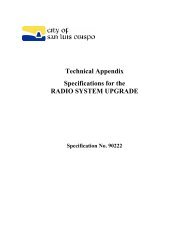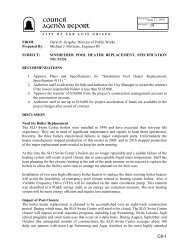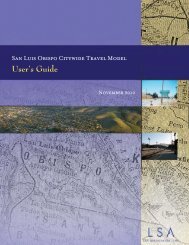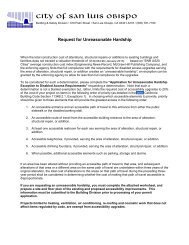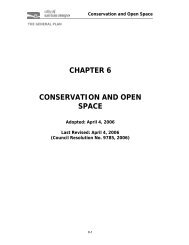Drainage Design Manual - the City of San Luis Obispo
Drainage Design Manual - the City of San Luis Obispo
Drainage Design Manual - the City of San Luis Obispo
Create successful ePaper yourself
Turn your PDF publications into a flip-book with our unique Google optimized e-Paper software.
cylindrical structures (Figure 6-1). They are placed in shallow trenches on contour. Theyare principally used to prevent slope erosion and very shallow slumping and rilling. Since<strong>the</strong>se techniques rely on rapid plant growth for stabilization, <strong>the</strong>y are best used on sunnysites, or in combination with erosion control blankets at most bank repair sites.• Erosion Control Fabric Planted w. Rooted Trees/Shrubs. This technique involvespreparing a smooth surface along <strong>the</strong> upper bank, seeding with grass and appropriatefertilizer, and covering this surface with an appropriate biodegradable erosion controlfabric (Figure 6-2). The erosion control fabric provides temporary protection againstsurface rilling and gullying while <strong>the</strong> grass becomes established and, when properlyinstalled and stapled to <strong>the</strong> ground, can provide protection against scour from high streamflow. Rooted native trees and shrubs selected based on <strong>the</strong> sun and water availability on<strong>the</strong> bank are planted through <strong>the</strong> erosion control fabric at relatively close spacings. Theseplantings are <strong>the</strong>n irrigated periodically for several years until <strong>the</strong>y become permanentlyestablished and can be counted on for permanent scour protection for <strong>the</strong> upper bank.This is one <strong>of</strong> <strong>the</strong> most labor-intensive upper bank protection techniques and is <strong>the</strong>preferred alternative for projects where toe erosion or stream velocities are not high orwhere equipment access is poor. At some locations use <strong>of</strong> rock toe protection is neededwith this technique.• Brush Layering. This technique is also called branch packing. It consists <strong>of</strong>constructing a slope fill section by alternating layers <strong>of</strong> live sprouting branches andcompacted earth backfill (Figure 6-3). The front <strong>of</strong> <strong>the</strong> live branches should protrudeslightly into <strong>the</strong> channel, while it is important that <strong>the</strong> butt ends contact native bank soilsat <strong>the</strong> rear <strong>of</strong> <strong>the</strong> fill. Brush layering can be used to repair small, localized slumps andholes in streambanks. The upper limit <strong>of</strong> <strong>the</strong> fill section should be less than 2.7 to 3meters (9 or 10 feet) in thickness, while depth can extend back 2.4 to 3 meters (8 to 10feet). Fill sections are designed in consideration <strong>of</strong> soil conditions, slope, and watervelocities. Typical vertical section spacing ranges from .9 to 1.5 meters (3 to5 feet), andslopes as steep as 1.5H: 1V can be constructed. This technique has limitations on dry orshady sites.• Brush Mattress. A brush mattress is a combination <strong>of</strong> live stakes (usually willow), livefascines or willow wattles, and branch cuttings installed to cover and stabilize erodingstreambanks (Figure 6-4). Usually twine or wire constructed and held in place usingstout stakes as a sort <strong>of</strong> cross-laced grid system is used to hold <strong>the</strong> brush down until some<strong>of</strong> it begins to sprout. This method can be used to form a live armor against fast flowingwater with abrasive power, but is less effective combating toe scour or slumping. Thebrush layer is usually cross-tied to <strong>the</strong> slope using stakes and rope or wire. Adequatechannel flow capacity must also exist. This technique is best used in rural areas where<strong>the</strong>re is a supply <strong>of</strong> brush near <strong>the</strong> job site, where inexpensive labor is available, andwhere banks are not particularly steep or high.• Fiber rolls/ fiber rock rolls/ coir erosion blankets. Fiber rolls are cylindrical structuresfilled with coconut husk fibers bound toge<strong>the</strong>r with twine woven from coconut(Figure 6-5) Typically <strong>the</strong>y are available in 304 mm to 457 mm (12 or 18 inches)SLO Creek <strong>Drainage</strong> <strong>Design</strong> <strong>Manual</strong> 71 February 2003




